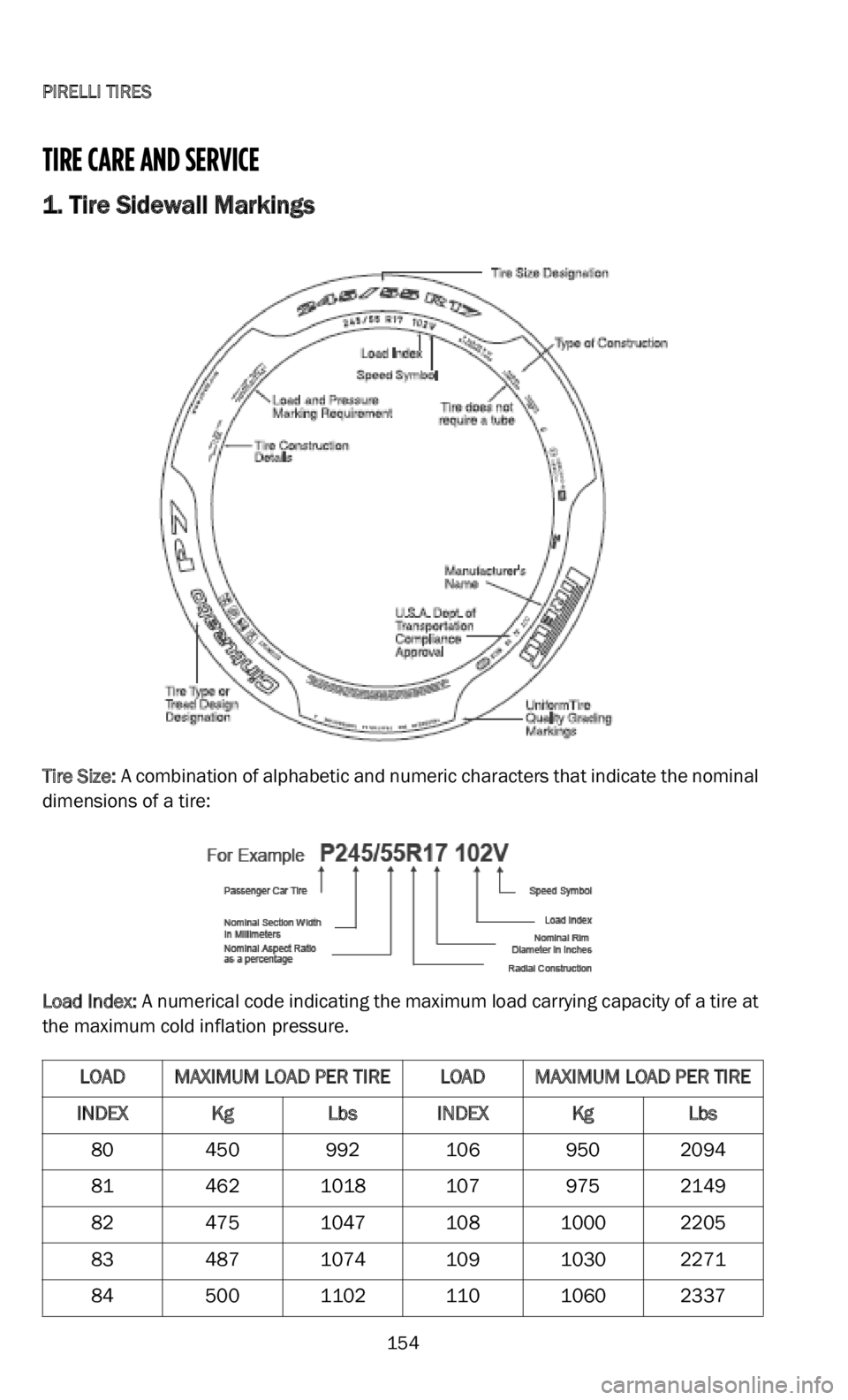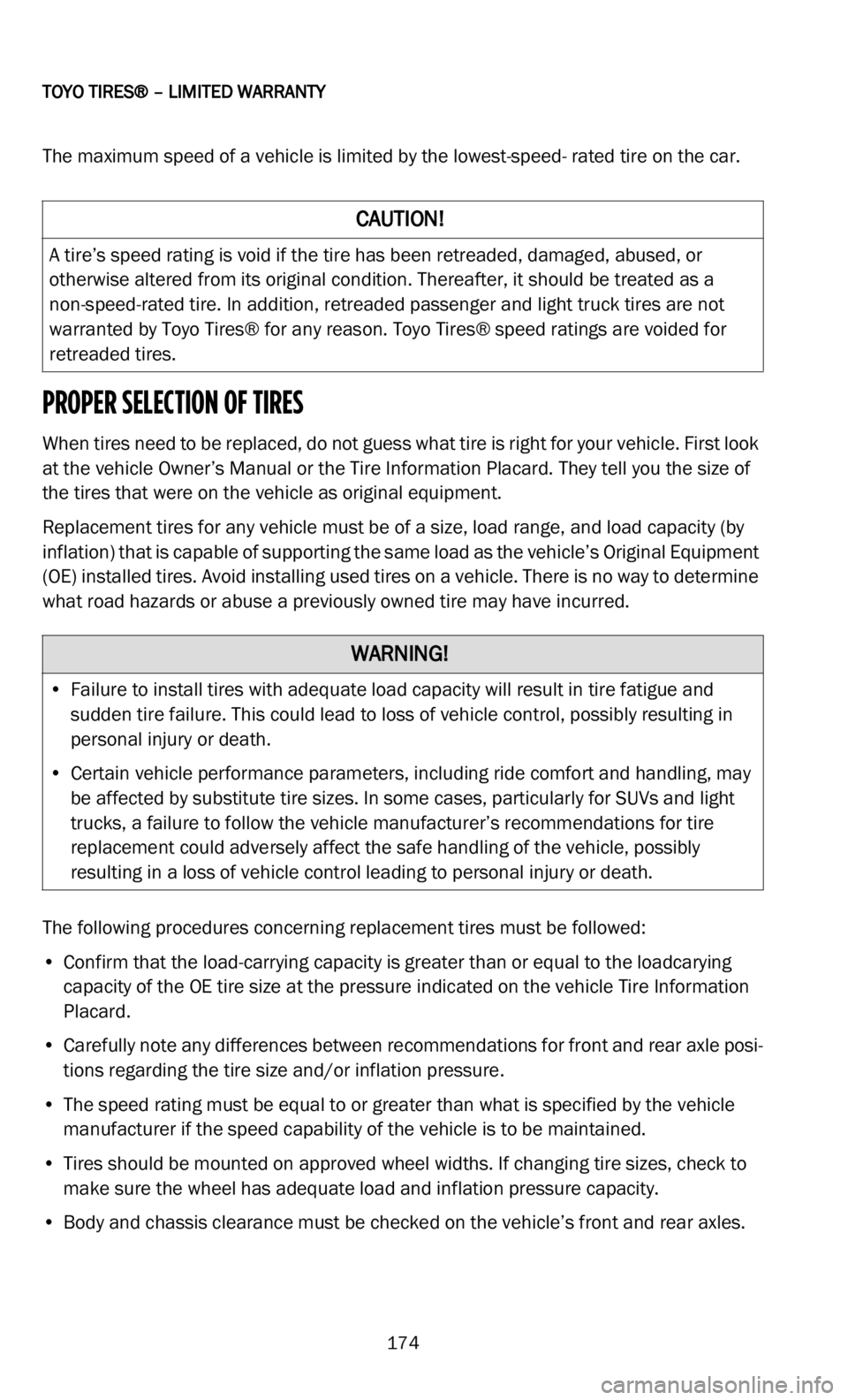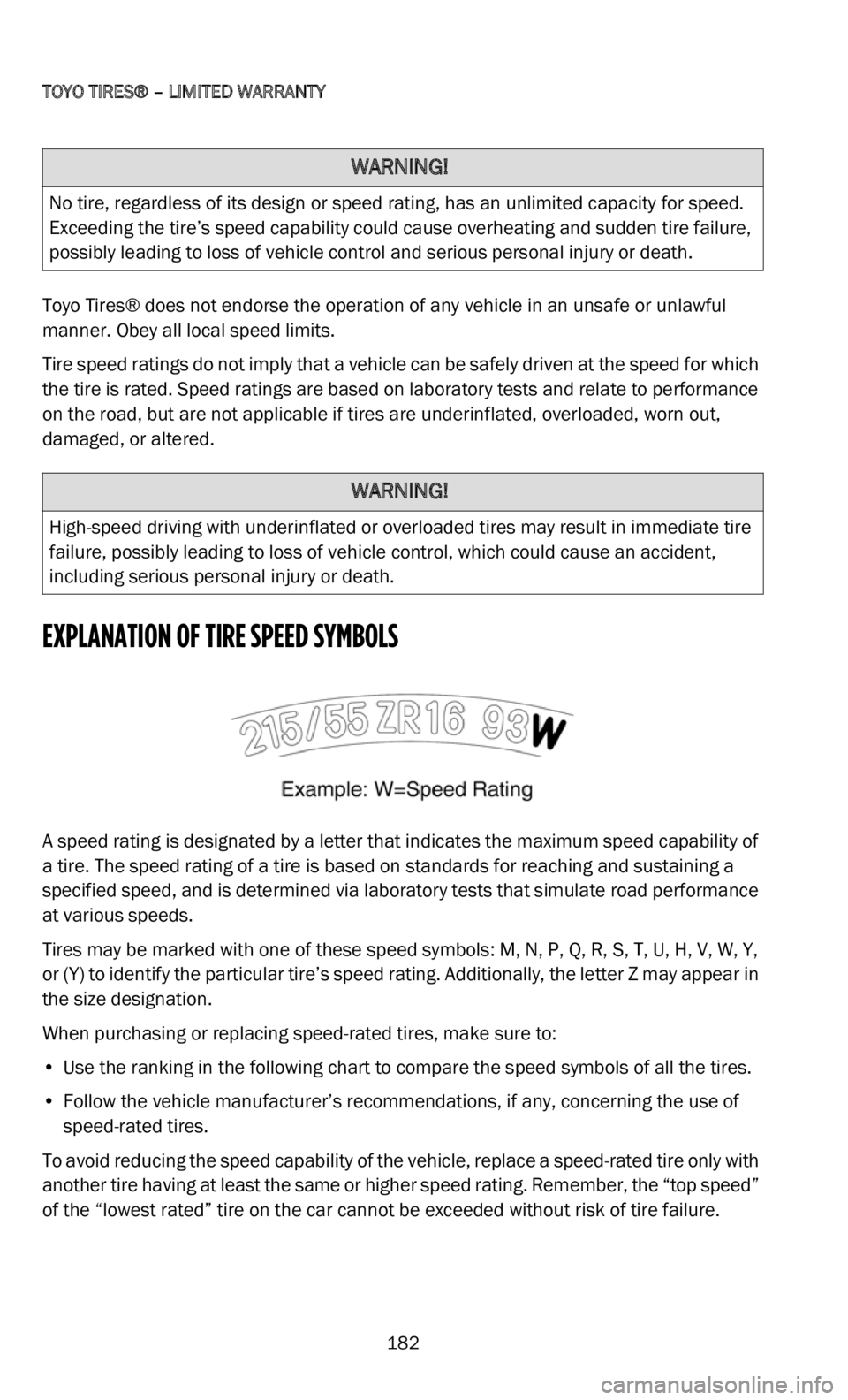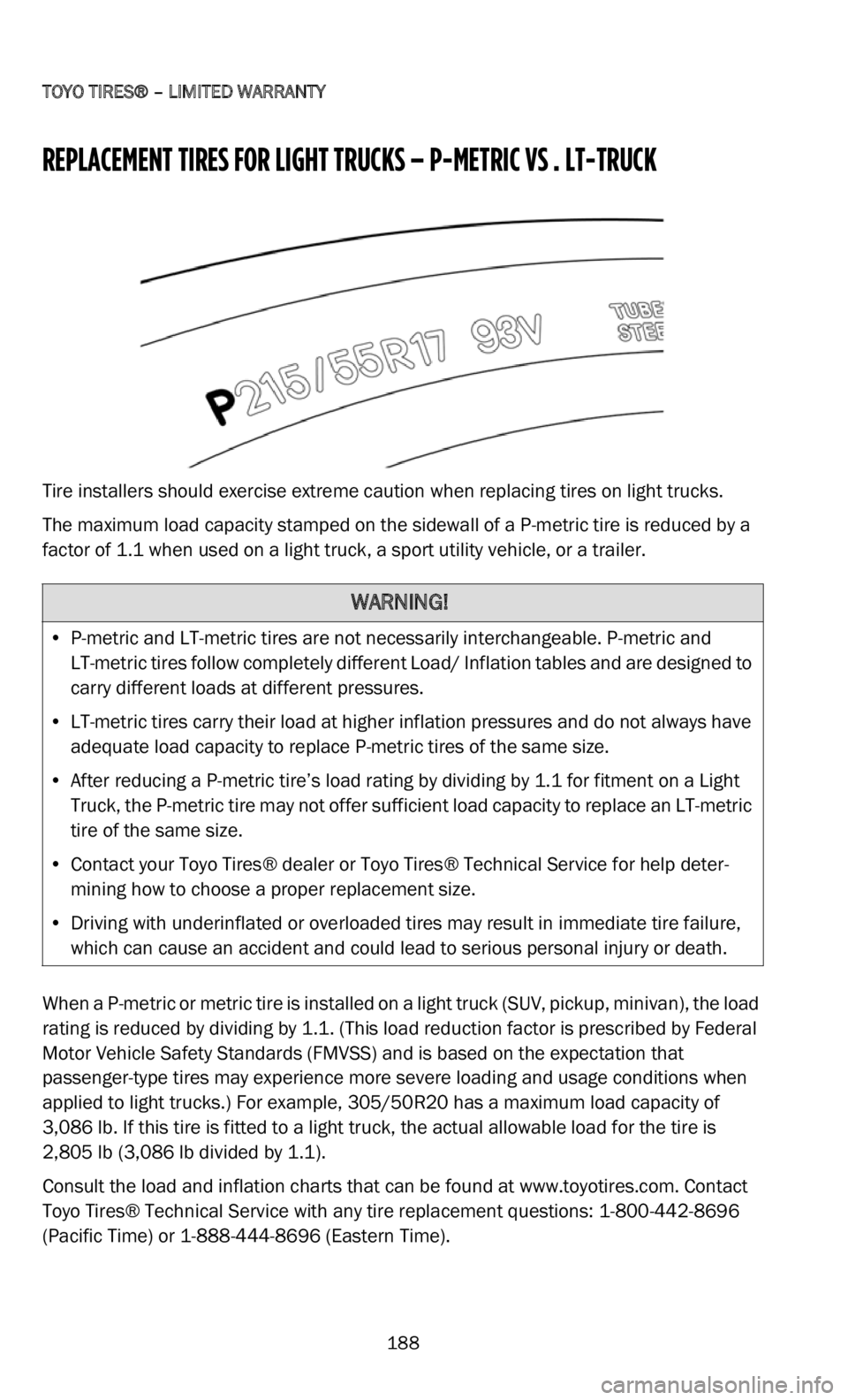load capacity DODGE DURANGO 2022 Vehicle Warranty
[x] Cancel search | Manufacturer: DODGE, Model Year: 2022, Model line: DURANGO, Model: DODGE DURANGO 2022Pages: 200, PDF Size: 6.72 MB
Page 97 of 200

GOODYEAR® DUNLOP® TIRES
96
•TIRE SPINNING. On slippery surfaces such as snow, mud, ice, etc., do not spin tires in
excess of 35 mph (55 km/h), as indicated on the speedometer.
• EXCESSIVE WHEEL SPINNING.
This can also result in tire disintegration or axle failure.
TIRE CARE AND MAINTENANCE GUIDE
The easiest way to help ensure satisfactory mileage and performance from your
Goodyear® or Dunlop® tires is to give them a simple but frequent (at least monthly)
inspection for proper inflation, even tread wear and the presence of any damage.
DO MAINTAIN PROPER INFLATION PRESSURE IN YOUR TIRES
Proper inflation pressure is necessary for optimum tire performance, safety and fuel
economy. Check inflation pressures at least once a month and before long trips. Use an
accurate tire pressure gauge. Always check pressures when the tires are cold (when the
vehicle has been driven less than one mile). If you must check inflation when the tires
are hot, add 4 psi (27 kPa) to the recommended cold inflation pressure. It is difficult to
tell just by looking at radial tires whether they are underinflated.*
Furthermore, when operating a vehicle equipped with radial tires, it is difficult to notice
wh
en a tire has gone flat or nearly flat since the “feel” of the vehicle does not change
significantly.
*Evidence of air loss or repeated underinflation always requires expert inspection to
d e
termine the source of leakage and tire removal to determine repairability. To avoid
injury, NEVER attempt to reinflate a tire that has been run severely underinflated.
Progressive air loss may result from punctures, cuts, curbing, impacts or partial bead
unseating. Some fitment causes for air loss are (1) incomplete bead seating, (2) bead
tearing caused by a machine tool due to insufficient lubrication or improper adjustment.
Leaking valve core or rubber valve components should be replaced when problems are
detected and whenever tires are replaced.
WARNING!
Vehicle handling, traction, ride comfort and other performance parameters may be
significantly affected by a change in tire size or type. Before replacing tires, always
consult and follow the vehicle Owner’s Manual because some vehicle manufacturers
prohibit changing tire size. When selecting tires that are different from the original
equipment size make certain:
• The tires have adequate load-carrying capacity based on the vehicle placard.
•
The tires have sufficient inflation pressure to carry the load.
•
There is proper clearance with no interference points between the tire and vehicle.
T
he consumer must be aware to always drive safely and obey all traffic laws. Avoid
s u
dden, sharp turns or aggressive lane changes. Failure to follow any of these
warnings may result in loss of control of the vehicle, leading to an accident and
serious injury or death.
Page 98 of 200

GOODYEAR® DUNLOP® TIRES
97
Always maintain inflation pressure at the level recommended by the vehicle
manufacturer as shown on the vehicle placard, vehicle certification label or in the vehicle
Owner’s Manual:
Underinflation is the leading cause of tire failure and may result in severe cracking,
c o
mponent separation or “blowout.” It reduces tire load capacity, allows excessive
sidewall flexing and increases rolling resistance, resulting in heat and mechanical
damage. Maintaining proper inflation pressure is the single most important thing you can
do to promote tire durability and maximize tread life.
Overinflation increases stiffness, which may deteriorate ride and generate unwanted
vi
bration. Overinflation also increases the chances of impact damage.
DON’T OVERLOAD YOUR VEHICLE
Check your vehicle Owner’s Manual to determine the load limits. Overloading your vehicle
places stress on your tires and other critical vehicle components. Overloading a vehicle can
cause poor handling or increased fuel consumption and may cause tire failure. Overloading
your tires can result in severe cracking, component separation or “blowout.”
Never fit your vehicle with new tires that have less load capacity than shown on the
ve
hicle tire placard and remember that optimum rim width is important for proper tire
load distribution and function. The maximum load capacity stamped on the sidewalls of
P-Metric & European Metric tires is reduced by 10% when used on a light truck, utility
vehicle or trailer. Never fit P-Metric or European Metric tires to light trucks that specify
LT-type replacement tires.
DO NOT SPIN YOUR TIRES EXCESSIVELY
Avoid excessive tire spinning when your vehicle is stuck in snow, ice, mud or sand. The
centrifugal forces generated by a free-spinning tire/wheel assembly may cause sudden
tire explosion, resulting in vehicle damage and/or serious personal injury to you or a
bystander. Never exceed 35 mph (55 km/h), as indicated on your speedometer. Use a
g e
ntle backward and forward rocking motion to free your vehicle for continued driving.
Never stand near or behind a tire spinning at high speeds, for example, while attempting
to push a vehicle that is stuck or when an on-the-car spin balance machine is in use.
DO CHECK YOUR TIRES FOR WEAR
Always remove tires from service when they reach 2/32 of an inch remaining tread
depth. All new tires have tread wear indicators which appear as smooth banks in the
tread grooves when they wear to the 2/32 of an inch level. Many wet weather accidents
result from skidding on bald or nearly bald tires. Excessively worn tires are also more
susceptible to penetrations.
Page 100 of 200

GOODYEAR® DUNLOP® TIRES
99
DO NOT MIX TIRES OF DIFFERENT SIZES AND TYPES ON THE SAME AXLE
For optimum handling and control, Goodyear® recommends fitment of four tires of the
same type and size unless otherwise specified by the vehicle manufacturer.
When replacing tires, you must maintain the outside diameter and load-carrying capacity
of
the Original Equipment tire. Inflation pressure may need to be adjusted to avoid
overloading the tire. Consult the Tire & Rim Association Load and Inflation Tables,
European Tire and Rim Technical Organization (ETRTO) or Japan Automobile Tyre
Manufacturers Association (JATMA) standards for correct load and inflation information.
NEVER FIT TIRES TO A VEHICLE THAT HAVE LESS LOAD-CARRYING CAPACITY THAN
RE
QUIRED BY THE ORIGINAL EQUIPMENT MANUFACTURER
Examples: Many vehicles, such as large passenger vans, require Load Range E tires as
d e
signated by the vehicle manufacturer. Fitment of a tire, such as a Load Range D, with
less carrying capacity is not allowed. In other cases, tires of the same size may carry
different load indexes in the service description. You must make certain the replacement
tires fitted to the vehicle have a load-carrying capacity equal to or greater than what the
Original Equipment manufacturer specifies.
NOTE:
Goodyear® manufactured and/or marketed European- Metric passenger tires and
P -
Metric passenger tires are interchangeable as long as they have the same section
width, same aspect ratio, same rim diameter.
FOLLOW THESE ADDITIONAL GUIDELINES
When installing only two tires, fit the tires with the deepest tread depth on the rear axle.
If radials and non-radials must be fitted to the same vehicle, fit radials on rear axle. Never
mix radials and non-radials on the same axle. When fitting winter tires or all-season tires
WARNING!
Before you replace your tires, always consult the vehicle owner’s manual and follow
the vehicle manufacturer’s replacement tire recommendations. Vehicle handling may
be significantly affected by a change in tire size or type. When selecting tires that are
different from the Original Equipment size, see a professional installer in order to
make certain that proper clearance, load-carrying capacity and inflation pressure are
selected. Never exceed the maximum load capacity and inflation pressure listed on
the sidewall of the tire. Always drive safely and obey all traffic laws. Avoid sudden,
sharp turns or aggressive lane changes. Failure to follow this warning may result in
loss of control of the vehicle, leading to an accident and serious injury or death.
CAUTION!
Never substitute a “Standard Load” (SL) tire for an Extra Load (XL) or Reinforced tire. If
the vehicle was originally equipped with “Extra Load” (XL) or Reinforced tires, replace
those tires with similar-sized Extra Load (XL) or Reinforced tires.
Page 129 of 200

MICHELIN®
128
should have the recommended pressure listed by your vehicle’s manufacturer. This
information can be found in the vehicle Owner’s Manual and often on a placard located
in the vehicle’s door jamb, inside the fuel hatch, or on the glove compartment door. If you
have a plus size fitment that requires a higher inflation pressure, your tire pressure
monitoring system will require re-calibration to new inflation pressure. Refer to your tire
dealer/installer of plus size tires for proper inflation pressure.
We recommend checking air pressure once each month, and before a long trip. Whether
yo
u have a full-sized or mini-spare, make sure that it is properly inflated as well. If the
TPMS generates improper monitoring or signals we recommend that you consult your
Owner’s Manual provided with your vehicle and follow-up with your vehicle’s
manufacturer.
TIRE SPINNING
Do not spin wheels in excess of 35 mph (55 km/h) as indicated on the speedometer.
Ex
cessive speed in a free-running, unloaded tire can cause it to “explode” from
centrifugal force. The energy released by such an explosion is sufficient to cause serious
physical injury or death. Never allow anyone to stand near or behind the spinning tire.
When in mud, sand, snow, ice or other slippery conditions, do not engage in excessive
w h
eel spin. Accelerating the motor excessively, particularly with automatic transmission
vehicles, may cause a drive tire that has lost traction to spin beyond its speed capability.
This is also true when balancing a drive tire/wheel assembly on the vehicle using the
vehicle engine to spin the tire/wheel assembly.
HIGH SPEED DRIVING CAN BE DANGEROUS
Correct inflation pressure is especially important. However, at high speeds, even with the
correct inflation pressure, a road hazard, for example is more difficult to avoid and if
contact is made, has a greater chance of causing tire damage than at a lower speed.
Moreover, driving at high speed reduces the reaction time available to avoid accidents
and bring your vehicle to a safe stop. If you see any damage to a tire or wheel, replace it
with the spare at once and visit a participating Michelin® tire retailer.
Exceeding the maximum speeds shown on the following page for each type of Michelin®
t i
re will cause the tire to build up excessive heat which can cause tire damage that could
result in sudden tire destruction and rapid air loss. Failure to control a vehicle when one
or more tires experience a sudden air loss can lead to an accident.
In any case, you should not exceed reasonable speeds as indicated by the legal limits
a n
d driving conditions.
SPEED RATINGS
Speed Symbols are shown on the sidewall of some Michelin® tires. The following table
shows the maximum speed corresponding to the symbol.
*Some V (or VR) rated tires may have a speed capacity greater than 149 mph (240 km/h).
C o
nsult your participating Michelin® tire retailer for maximum speed rating if your vehicle
capability exceeds this speed.
Page 144 of 200

NEXEN TIRE
143
as measured from shoulder to shoulder on the claim tire, and compared to the
remaining tread depth of the opposite front/rear or left/right tire.
• C omplete and sign the Nexen Tire Claim Adjustment form provided by the dealer, keep
a
copy for your records and leave the tire with the dealer for warranty processing.
ROADSIDE ASSISTANCE
Patterns sold after May 1, 2014 by Nexen Tire in the United States and Canada are
eligible for a free 24/7/365 Roadside Assistance for a period of 36 months from the
p u
rchase date. Upon purchasing Nexen Tires, the consumer will receive an activation
card from the tire shop. An online registration needs to be completed in order to have
access to a toll free phone number to call in case of a flat tire. A qualified professional
will change your flat tire with your spare tire free of charge. If a working spare is not
available, towing will be provided free of charge to the nearest Nexen Tire dealer or
authorized place of repair.
*Nexen Tire reserves the right to change the terms and conditions of all warranties at
a n
y time.
TIRE CARE AND MAINTENANCE GUIDE
Tire failure can result in serious damage and/or personal injury. To reduce the risk of tire
failure we recommend the following:
• M aintain proper inflation pressure and do not use at underinflation or overinflation.
P
ressure should be set at the level recommended by vehicle manufacturer.
• W heel alignment and balancing should be checked at regular intervals.
•
Do not overload. The maximum load carrying capacity is molded on the sidewall of the
t
ire.
• D o not spin your tires excessively and avoid driving over curbs, potholes, obstacles
a
nd edges of pavement.
• N ever drive on smooth (bald) tires. By law, tires must be replaced when 2/32 of an
i
nch of tread depth remained, as indicated by tread wear indicator molded in the tread
grooves.
• C heck your tires frequently for any scrapes, cuts, foreign objects, separations or
b
ulges. If damage is found, do not attempt to dismount a tire yourself. Change
damaged tire with the spare and contact a local authorized Nexen Tire dealer imme -
diately.
• D o not drive in excess of speed limits allowed by law or the maximum speed justified
b
y driving conditions.
• T o achieve proper even wear and gain maximum tread life, tire rotation at regular
i
ntervals is required.
Page 155 of 200

PIRELLI TIRES
154
TIRE CARE AND SERVICE
1. Tire Sidewall Markings
Tire Size: A combination of alphabetic and numeric characters that indicate the nominal
dimensions of a tire:
Load Index: A
numerical code indicating the maximum load carrying capacity of a tire at
the maximum cold inflation pressure.
LOAD MAXIMUM LOAD PER TIRE LOADMAXIMUM LOAD PER TIRE
INDEX KgLbsINDEX KgLbs
80 450 9921069502094
81 4621018 1079752149
82 4751047 1081000 2205
83 4871074 1091030 2271
84 5001102 1101060 2337
Page 160 of 200

PIRELLI TIRES
159
8. Tire Replacement
The tires fitted to your vehicle as original equipment were tested and approved by the
vehicle manufacturer and the tire manufacturer and take into account all aspects of the
vehicle’s operation. Changes in the tire size, type or construction should not be made
without seeking advice from the vehicle or tire manufacturer or an authorized Pirelli
dealer since unapproved tires on your vehicle could adversely affect steering, handling,
braking and traction. The tire information (tire size, load index and speed symbol) as
found on the vehicle placard or in the owner’s manual should always be followed when
replacing tires.
It is strongly recommended that Pirelli tires be mounted in sets of four with the same
t r
ead type. Pirelli tires should not be mixed with other tire brands. It is necessary to follow
this procedure because different tire constructions have different handling
characteristics. Tires on the same axle must be the same manufacturer, brand, tire size,
load index, speed rating and Pirelli part number.
When changing only two tires on a vehicle which is homogeneously fitted (four tires of the
sa
me tire size), fit the new tires on the rear axle. This applies to all vehicles regardless of
their drive axle. (Front or Rear Drive).
On all wheel drive or four wheel drive vehicles the tires must always be replaced in sets
o f
four.
When replacing tires on light truck vehicles, you should always follow the vehicle
m a
nufacturer’s recommendations. Passenger and light truck tires are not
interchangeable, due to differences in their pressures and load carrying capacity.
P-Metric and Euro-metric Interchangeability: Euro-metric (Example: 225/45R17) tires
h a
ve a load index which is equal to or greater than that of the same size P-metric
(Example: P225/45R17) tire. Therefore, they have the same or higher load carrying
capacity at the maximum rated inflation pressure. Always check with your tire dealer or
Pirelli Tire Consumer Affairs to be sure of the exact interchangeability to maintain proper
vehicle dynamics.
Please be aware that it is important that, before fitting the suggested tires, the fitment is
a l
lowed by the technical specifications of the vehicle, the vehicle manufacturer and the
relevant homologations. Pirelli Tire does not express any view as to the compatibility of
the wheel/tire combination with the technical specifications for the chassis and vehicle.
TO MAINTAIN PROPER VEHICLE DYNAMICS AND LOAD CARRYING CAPACITY,
R E
PLACEMENT TIRES MUST ALWAYS HAVE A LOAD INDEX AND SPEED SYMBOL EQUAL
TO OR GREATER THAN THOSE FITTED AS ORIGINAL EQUIPMENT.
When making plus size fitments, you should consult with the dealer regarding any
s u
spension or braking system modifications which may be recommended for the vehicle.
9. Tire Inspection
As a minimum, tires (including the spare tire) should be examined and air pressure
checked monthly and always prior to long trips. They should also be examined if you
strike any unusual object on the road. Tires showing bulges, cracks, cuts, penetrations
or uneven wear must be dismounted and examined by an authorized Pirelli tire dealer
Page 175 of 200

TOYO TIRES® – LIMITED WARRANTY
174
The maximum speed of a vehicle is limited by the lowest-speed- rated tire on the car.
PROPER SELECTION OF TIRES
When tires need to be replaced, do not guess what tire is right for your vehicle. First look
at the vehicle Owner’s Manual or the Tire Information Placard. They tell you the size of
the tires that were on the vehicle as original equipment.
Replacement tires for any vehicle must be of a size, load range, and load capacity (by
in
flation) that is capable of supporting the same load as the vehicle’s Original Equipment
(OE) installed tires. Avoid installing used tires on a vehicle. There is no way to determine
what road hazards or abuse a previously owned tire may have incurred.
The following procedures concerning replacement tires must be followed:
• C onfirm that the load-carrying capacity is greater than or equal to the loadcarying
c
apacity of the OE tire size at the pressure indicated on the vehicle Tire Information
Placard.
• C arefully note any differences between recommendations for front and rear axle posi -
t
ions regarding the tire size and/or inflation pressure.
• T he speed rating must be equal to or greater than what is specified by the vehicle
m
anufacturer if the speed capability of the vehicle is to be maintained.
• T ires should be mounted on approved wheel widths. If changing tire sizes, check to
m
ake sure the wheel has adequate load and inflation pressure capacity.
• B ody and chassis clearance must be checked on the vehicle’s front and rear axles.
CAUTION!
A tire’s speed rating is void if the tire has been retreaded, damaged, abused, or
otherwise altered from its original condition. Thereafter, it should be treated as a
non-speed-rated tire. In addition, retreaded passenger and light truck tires are not
warranted by Toyo Tires® for any reason. Toyo Tires® speed ratings are voided for
retreaded tires.
WARNING!
• Failure to install tires with adequate load capacity will result in tire fatigue and
sudden tire failure. This could lead to loss of vehicle control, possibly resulting in
personal injury or death.
• C ertain vehicle performance parameters, including ride comfort and handling, may
b
e affected by substitute tire sizes. In some cases, particularly for SUVs and light
trucks, a failure to follow the vehicle manufacturer’s recommendations for tire
replacement could adversely affect the safe handling of the vehicle, possibly
resulting in a loss of vehicle control leading to personal injury or death.
Page 183 of 200

TOYO TIRES® – LIMITED WARRANTY
182
Toyo Tires® does not endorse the operation of any vehicle in an unsafe or unlawful
manner. Obey all local speed limits.
Tire speed ratings do not imply that a vehicle can be safely driven at the speed for which
th
e tire is rated. Speed ratings are based on laboratory tests and relate to performance
on the road, but are not applicable if tires are underinflated, overloaded, worn out,
damaged, or altered.
EXPLANATION OF TIRE SPEED SYMBOLS
A speed rating is designated by a letter that indicates the maximum speed capability of
a tire. The speed rating of a tire is based on standards for reaching and sustaining a
specified speed, and is determined via laboratory tests that simulate road performance
at various speeds.
Tires may be marked with one of these speed symbols: M, N, P, Q, R, S, T, U, H, V, W, Y,
o r
(Y) to identify the particular tire’s speed rating. Additionally, the letter Z may appear in
the size designation.
When purchasing or replacing speed-rated tires, make sure to:
• U se the ranking in the following chart to compare the speed symbols of all the tires.
•
Follow the vehicle manufacturer’s recommendations, if any, concerning the use of
s
peed-rated tires.
To avoid reducing the speed capability of the vehicle, replace a speed-rated tire only with
a n
other tire having at least the same or higher speed rating. Remember, the “top speed”
of the “lowest rated” tire on the car cannot be exceeded without risk of tire failure.
WARNING!
No tire, regardless of its design or speed rating, has an unlimited capacity for speed.
Exceeding the tire’s speed capability could cause overheating and sudden tire failure,
possibly leading to loss of vehicle control and serious personal injury or death.
WARNING!
High-speed driving with underinflated or overloaded tires may result in immediate tire
failure, possibly leading to loss of vehicle control, which could cause an accident,
including serious personal injury or death.
Page 189 of 200

TOYO TIRES® – LIMITED WARRANTY
188
REPLACEMENT TIRES FOR LIGHT TRUCKS – P-METRIC VS . LT-TRUCK
Tire installers should exercise extreme caution when replacing tires on light trucks.
The maximum load capacity stamped on the sidewall of a P-metric tire is reduced by a
fa
ctor of 1.1 when used on a light truck, a sport utility vehicle, or a trailer.
When a P-metric or metric tire is installed on a light truck (SUV, pickup, minivan), the load
r a
ting is reduced by dividing by 1.1. (This load reduction factor is prescribed by Federal
Motor Vehicle Safety Standards (FMVSS) and is based on the expectation that
passenger-type tires may experience more severe loading and usage conditions when
applied to light trucks.) For example, 305/50R20 has a maximum load capacity of
3,086 lb. If this tire is fitted to a light truck, the actual allowable load for the tire is
2,805 lb (3,086 lb divided by 1.1).
Consult the load and inflation charts that can be found at www.toyotires.com. Contact
Toyo Tires® Technical Service with any tire replacement questions: 1 -
800-442-8696
(Pacific Time) or 1-888-444-8696 (Eastern Time).
WARNING!
• P-metric and LT-metric tires are not necessarily interchangeable. P-metric and LT-metric tires follow completely different Load/ Inflation tables and are designed to
carry different loads at different pressures.
• LT -metric tires carry their load at higher inflation pressures and do not always have
a
dequate load capacity to replace P-metric tires of the same size.
• A fter reducing a P-metric tire’s load rating by dividing by 1.1 for fitment on a Light
T
ruck, the P-metric tire may not offer sufficient load capacity to replace an LT-metric
tire of the same size.
• C ontact your Toyo Tires® dealer or Toyo Tires® Technical Service for help deter -
m
ining how to choose a proper replacement size.
• D riving with underinflated or overloaded tires may result in immediate tire failure,
w
hich can cause an accident and could lead to serious personal injury or death.